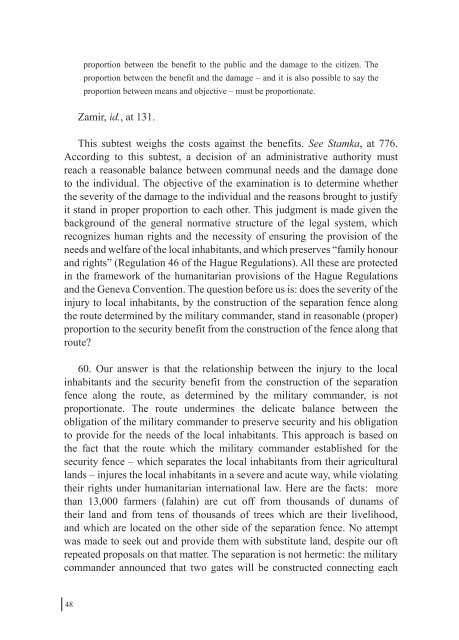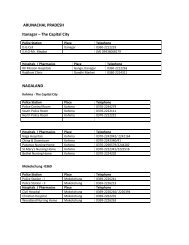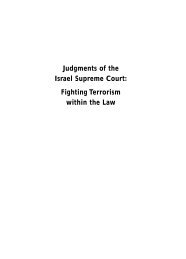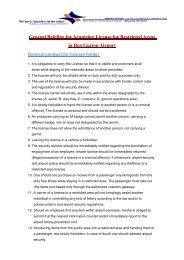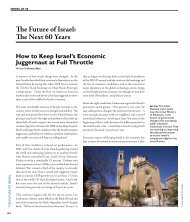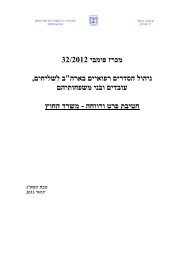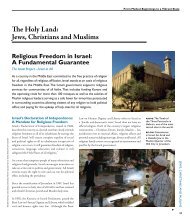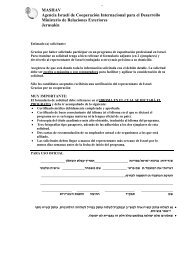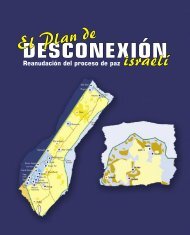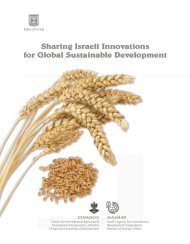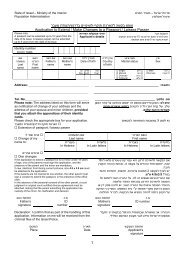Judgments of the Israel Supreme Court: Fighting Terrorism within ...
Judgments of the Israel Supreme Court: Fighting Terrorism within ...
Judgments of the Israel Supreme Court: Fighting Terrorism within ...
You also want an ePaper? Increase the reach of your titles
YUMPU automatically turns print PDFs into web optimized ePapers that Google loves.
proportion between <strong>the</strong> benefit to <strong>the</strong> public and <strong>the</strong> damage to <strong>the</strong> citizen. The<br />
proportion between <strong>the</strong> benefit and <strong>the</strong> damage – and it is also possible to say <strong>the</strong><br />
proportion between means and objective – must be proportionate.<br />
Zamir, id., at 131.<br />
This subtest weighs <strong>the</strong> costs against <strong>the</strong> benefits. See Stamka, at 776.<br />
According to this subtest, a decision <strong>of</strong> an administrative authority must<br />
reach a reasonable balance between communal needs and <strong>the</strong> damage done<br />
to <strong>the</strong> individual. The objective <strong>of</strong> <strong>the</strong> examination is to determine whe<strong>the</strong>r<br />
<strong>the</strong> severity <strong>of</strong> <strong>the</strong> damage to <strong>the</strong> individual and <strong>the</strong> reasons brought to justify<br />
it stand in proper proportion to each o<strong>the</strong>r. This judgment is made given <strong>the</strong><br />
background <strong>of</strong> <strong>the</strong> general normative structure <strong>of</strong> <strong>the</strong> legal system, which<br />
recognizes human rights and <strong>the</strong> necessity <strong>of</strong> ensuring <strong>the</strong> provision <strong>of</strong> <strong>the</strong><br />
needs and welfare <strong>of</strong> <strong>the</strong> local inhabitants, and which preserves “family honour<br />
and rights” (Regulation 46 <strong>of</strong> <strong>the</strong> Hague Regulations). All <strong>the</strong>se are protected<br />
in <strong>the</strong> framework <strong>of</strong> <strong>the</strong> humanitarian provisions <strong>of</strong> <strong>the</strong> Hague Regulations<br />
and <strong>the</strong> Geneva Convention. The question before us is: does <strong>the</strong> severity <strong>of</strong> <strong>the</strong><br />
injury to local inhabitants, by <strong>the</strong> construction <strong>of</strong> <strong>the</strong> separation fence along<br />
<strong>the</strong> route determined by <strong>the</strong> military commander, stand in reasonable (proper)<br />
proportion to <strong>the</strong> security benefit from <strong>the</strong> construction <strong>of</strong> <strong>the</strong> fence along that<br />
route?<br />
60. Our answer is that <strong>the</strong> relationship between <strong>the</strong> injury to <strong>the</strong> local<br />
inhabitants and <strong>the</strong> security benefit from <strong>the</strong> construction <strong>of</strong> <strong>the</strong> separation<br />
fence along <strong>the</strong> route, as determined by <strong>the</strong> military commander, is not<br />
proportionate. The route undermines <strong>the</strong> delicate balance between <strong>the</strong><br />
obligation <strong>of</strong> <strong>the</strong> military commander to preserve security and his obligation<br />
to provide for <strong>the</strong> needs <strong>of</strong> <strong>the</strong> local inhabitants. This approach is based on<br />
<strong>the</strong> fact that <strong>the</strong> route which <strong>the</strong> military commander established for <strong>the</strong><br />
security fence – which separates <strong>the</strong> local inhabitants from <strong>the</strong>ir agricultural<br />
lands – injures <strong>the</strong> local inhabitants in a severe and acute way, while violating<br />
<strong>the</strong>ir rights under humanitarian international law. Here are <strong>the</strong> facts: more<br />
than 13,000 farmers (falahin) are cut <strong>of</strong>f from thousands <strong>of</strong> dunams <strong>of</strong><br />
<strong>the</strong>ir land and from tens <strong>of</strong> thousands <strong>of</strong> trees which are <strong>the</strong>ir livelihood,<br />
and which are located on <strong>the</strong> o<strong>the</strong>r side <strong>of</strong> <strong>the</strong> separation fence. No attempt<br />
was made to seek out and provide <strong>the</strong>m with substitute land, despite our <strong>of</strong>t<br />
repeated proposals on that matter. The separation is not hermetic: <strong>the</strong> military<br />
commander announced that two gates will be constructed connecting each<br />
48


